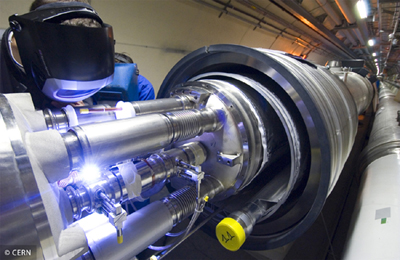Revolutionary Cancer Treatment Developed From Hadron Collider
Constructed to re-create the conditions of the Big Bang, the technology behind the world’s largest particle accelerator could now be used to revolutionise cancer treatment for thousands of patients

CERN scientists are developing a new and more effective alternative to radiotherapy which treats tumours with high-powered beams of positively charged particles at a greater accuracy than current radiotherapy techniques. Proton beam therapy enables doctors to precisely target tumors with a focused beam of protons, leaving the nearby tissue undamaged which minimises the risk of unpleasant side effects.
The project, Adam SA, focuses on designing particle accelerators at a smaller size than the 250ft rings required at CERN. Physicists are currently working on a compact linear accelerator, small enough to be easily installed in hospitals.
Proton beam therapy is currently available in just 32 hospitals around the world with only one in the UK. Two more proton beam therapy centres are planned in Britain however treatment can cost between £90,000 and £120,000 per patient.
Adam SA has been recently acquired by UK cancer firm Advanced Oncotherapy (AVO) with plans of developing compact and cheaper machines so that they can be more widely available. Dr. Michael Sinclair, the chief executive of AVO intends to install 10 new machines within the next 5 years which would treat 12,000 private and NHS patients annually.
Mr. Sinclair stated: “Proton beam therapy offers a significant improvement for patients with cancer than conventional radiotherapy, but so far the big problem has always been the cost.
“The machine developed by CERN has significant clinical advantages and will cost a third of equivalent equipment that is currently available.”
The Large Hadron Collider has now powered down for two years while it undergoes a £70 million upgrade. Engineers will carry out a revamp to help it reach maximum energy levels that could lead to more landmark discoveries. This break will allow the installation of 10,000 redesigned superconducting cables that connect between the magnets, vastly improving the machine’s capacity to simulate the conditions after the big bang.
Fine Tubes produced and supplied over 130km of cooling tubes for the beam screens of the LHC arc magnets that carry a flow of supercritical helium. Operating at cryogenic temperatures, the tubes were manufactured from a specially developed austenitic stainless steel grade to withstand the extreme conditions.
CONTACT
Brian Mercer
Fine Tubes Ltd
bmercer@fine-tubes.co.uk
www.finetubes.com
+44 (0) 1752 697216
Wednesday 8 May 2013 / file under Technology | Medical | Engineering



